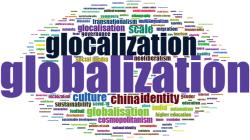Exploring East and Southeast Asia through the Glocalization of Language
Smiti Iyer
03 January 2024
IRGA Jan-Feb Issue 2024

Image Credits: Holidify
Globalisation refers to the process of integration and interaction among people and different stakeholders worldwide in domains like economic, social and cultural. It is a cause for the growth of international trade and the exchange of ideas. A cultural pastiche- a global culture that inspires each other- characterises globalisation, thus becoming a key component of world culture (Featherstone & Lash, 1995; Abu-Lughod, 1997; and Friedman, 1994). Robertson (1992) mentions that the global interpenetrates the local. It provides the notion of heterogeneity in which a variety of cultures interacts to create a blend. Robertson's conceptualisation remains mostly irrefutable and lies in the issue of temporality, which has led to the rise of the term 'glocalisation'. This phenomenon heavily affects the localised social, political, cultural and business strategies (food, fashion, music, and language). It casts doubt on the idea of a single, predominant global culture and emphasises the value of cultural diversity and local context (Oxford, 2023). 'Glocalisation' means dochakuka in Japanese, meaning 'global localisation', reflecting how Japanese companies have expanded their businesses internationally (Khondker, 2004). In the 20th and 21st Centuries, the rise of the robust practice of glocalisation can be seen in many Southeast Asian countries.

Some form of glocalisation is present in the often-cited example of McDonaldization. It is a process by which this fast food restaurant's principles dominate many sectors of America and other societies worldwide. Taiwan is an excellent illustration of it. In Taiwan, the employment of five to ten female receptionists is called 'Aunt McDonalds', just as Ronald McDonald (the mascot) is considered 'Uncle McDonald'. With respect to Starbucks, its Chinese branch serves Zhongzi- a traditional dish, to celebrate festivals nationwide.
Glocalisation is vividly reflected in the field of music, too. Big cities such as Singapore, Bangkok and Kuala Lumpur have experienced tremendous growth in Japanese music sales. It led to the rise of Japanese recordings in the Top Ten of the Recording Industry Association of Singapore (RIAS). Japanese music, or J-pop, also impacts other music fields like Singapore Pop music, leading to the emergence of two forces: The 'Japanization of Asian Music' and the 'Asianization of Japanese Music'. Hong Kong and Taiwan played a significant role as mediums in the popularisation of Japanese pop in Singapore. Many J-pop CDs, VCDs, magazines and other merchandise, both licensed and pirated, are made in countries like China (mainly Hong Kong), Taiwan, Malaysia, and Thailand. These are then made available in many Asian markets like Singapore, where the Taiwan-made J-pop albums are top-rated, featuring the latest J-pop songs that get sold out at a reasonable price. A substantial Chinese fanbase, mainly Mandarin and Cantonese, covers various versions of J-pop songs, including Taiwanese and Hong Kong artists, who have helped popularise J-pop among their communities. These artists make new covers by adding their unique creativity to the original one or translating the song into their native language. One such criticism or drawback is that Taiwan still needs to sign an Agreement on Copyright Protection with the Japanese Recording Agency, and the latter has subsequently shown its concerns.


Concerning languages, glocalisation again plays a prominent role. English Language Teaching, or ELT, is widely practised in South Korea. Many new Korean words get their formulation from the English language. At the beginning of the twentieth century, English began to be taught in Korea when the United States suggested opening the Korean Peninsula to expand its military and economic prowess. Due to such pressures from the imperialist powers, the Korean Government made some significant changes to the policies in the education sector to meet the country's needs. The transformation of Hansung English School (1894) to Hansung Foreign School (1906) is an example of such change in its educational policies. However, with the emergence of Japanese colonisation, the Japanese Government initiated the abolition of this institution through the Educational Act of Chosun in 1910, leading to the prohibition of teaching the English Language for a decade. After the liberation from Japanese colonisation, English became a survival tool due to the US military government that ruled Korea, impacting people's lifestyles. Eventually, the authorities organised a few English programmes. Its primary purpose was to improve the proficiency of government officials, military staff, students and other citizens through traditional methods. Based on the curricular materials and instructional activities, grammar, vocabulary learning, and memorisation were used widely. Currently, it is observed that many Korean words are also similar to some English words, like the emergence of many 'Konglish' words such as oh-ran-gee (orange), koh-pee (coffee), jeu-seu (juice), mil-keu-shae-ee-keu (milkshake), pi-jah (pizza).

Southeast and East Asian cinemas are now the subject of considerable academic enquiry in the Western world. Many such books have stressed the single national cinema, mainly the Japanese and Chinese cinemas, since the 1980s. Scholars have connected Asian Cinema under two themes, melodrama and colonialism, which remained isolated and have led to the emergence of books on other genres of Asian Cinema. In the anthology 'Transnational Chinese Cinemas: Identity, Nationhood, Gender' by Sheldon Hsiao-peng Lu, Asian cinemas are addressed in a transnational context. Many more books on different Asian cinemas over the years came out in English, such as 'The Cinemas of Japan and Korea' (2004) and 'East Asian Cinema' (2007). Singaporean and Malaysian Cinemas portray a comprehensive picture of broad-based Asian Cinema in the book 'Contemporary Asian Cinema: Popular Culture in a Global Frame' (2006). Certain books group East Asian films under specific study of gender and sexuality, while others deal with genres like horror. However, there is a viable criticism that film scholars still need to catch up in the transnational analysis of popular culture. The publication of some of the anthologies of East Asian Cinemas about multiple modernities ignores the Orientalist convention of seeing East Asia as a single uniform block that needs to be examined separately.


Therefore, globalisation today is a multidisciplinary approach, where various stakeholders worldwide interact and deliberate about economic, social and cultural realms to unite the world. In this way, it also emphasises the universalisation of particularism and vice versa, leading to 'glocalisation', meaning dochakuka in Japanese. The practice of glocalisation in Southeast and East Asia can be widely seen all over the region in various domains of rebranding, music, language and film studies. It reflects the significant value of cultural diversity and local context and contests any hegemonisation of a particular culture.
REFERENCES :
Arsel, Z., & Thompson, C. J. (2004). The Starbucks brandscape and consumers' (Anticorporate) experiences of glocalization author. Journal of Consumer Research, 31(3), 631-642.
Arslan, I. K., & Bozkurt, A. D. (2023). The effect of intercultural interaction on the glocalization of Doner Kebab. Journal of International Trade, 9(1), 261-277.
Malone, E. L., & Ritzer, G. (2000); Featherstone & Lash (1995); Lughod, A. (1997); Friedman (1994); Robertson (1992), Globalization theory: lessons from the exportation of McDonaldization and the new means of consumption. American Studies, 41(2/3), 97-118.
Ming, B. W. (2003). Japanese popular music in Singapore and the hybridisation of Asian music. Asian Music, 34(1), 1-18.
Roudometof, V. N. (2016). Glocalisation: a critical introduction. European Journal of Social Theory, 19(3), 391-408. https://doi.org/10.1177/1368431015605443
Sung, K. (2007). Glocalizing critical pedagogy: A case of critical English language teaching in Korea. Counterpoints, 299, 163-181.
Tonglin, L. (2010). Transnationalism and Glocalisation in Chinese Language and East Asian Cinemas Author. China Review, 10(2), 1-14.
.png)

.jpg)